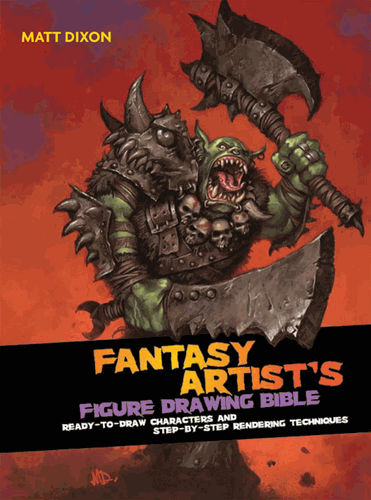Fantasy Artist’s Figure Drawing Bible: Ready-to-Draw Characters and Step-by-Step Rendering Techniques
Let’s start off with an introduction of the author of The Fantasy Artist’s Figure Drawing Bible, Matt Dixon. How is Matt Dixon qualified to teach anyone about drawing fantasy figures? Well, he has produced art for various video game companies, including Sony Online Entertainment, and Blizzard Entertainment. I think he’s pretty qualified to teach young artists how to draw and paint. You can see his website here. You can see his blog here.
Here are some images of Matt Dixon’s work, taken from his website at mattdixon.co.uk:
Those paintings look pretty awesome, don’t they? Yes, yes they do. He seems pretty qualified to write a book about fantasy figure drawing, so let’s talk about the book.
At the time of this writing, The Fantasy Artist’s Figure Drawing Bible was $17.31 with free shipping (on orders over $35) on Amazon. That’s not too shabby for a book with 256 pages, albeit each page is only 5.75″ x 7.75″, so what normally might take up one page in a normal sized art book, could take up three pages in this book (that’s not an actual page rate, I’m just throwing out a estimate). The version of the book that I read is a spiral bound hardcover book. I don’t think I’ve ever read an art book that was spiral bound before this book (And I have read A LOT of art books). It’s not a bothersome format. The spiral bound format is nice because you can have the book open to any set of pages and not worry about having to weigh down one side of the book so the pages don’t fall back onto the other side (If you don’t know what I’m talking about, then try reading a book sometime by just laying it on the table).
The figure drawing bible was first published in 2008 by Barron’s Educational Series, Inc. (or Quarto Inc. I’m not sure if one of those companies is an imprint or not and the inside cover of the book doesn’t really tell me). The book begins with 2 pages that quickly describe how the book is laid out (and once you get to the character directory you will see that it’s the same several page layout for each character). Then there are 6 pages of fantasy artwork (one image per page) from artists such as Jonny Duddle, and Howard Lyon.
Next up is the “Getting Started” chapter, and in this section there are 10 pages total. The first section of the “Getting Started” chapter is 2 pages that list various artists and illustrators, as well as literature, movies, and places that can be of inspiration to the artist reading the book. After that, there are 4 pages that discuss tools and materials. The tools and materials section is very brief and is probably only helpful to the beginner artist. Dixon then compares a couple of techniques (Line vs tinted vs comic etc.), and then briefly talks about working digitally.
After the “Getting Started” chapter, we reach 34 pages about visual language. This chapter discusses things such as fantasy stereotypes, anatomy proportions, constructing the figure, composition, sketching, value, color, and rendering. The rendering section is my favorite part of the book, probably because I am already very familiar with the other rudimentary principles of art. It’s always nice to see an artist’s workflow and process.
Next up there is the “Character Directory”, which is the bulk of the book. In the character directory you are presented with a fantasy character or archetype. There is a full page illustration showing that character and the line art drawing if you wanted to trace or scan the drawing into your computer and try your hand at digital rendering. Dixon talks about the personality of the character, the design choices, developing the design and appearance of the character (including the face, body shape, weapons, etc.), constructing the character and posing them. Also included in each character section is a half page “Artist’s Tip” that can discuss anything from digitally painting skin tones to atmospheric perspective. The book uses the same format for each character, making it easy to digest. Some of the characters in the book include: imp, elf, dark elf, dwarf, mermaid, orc, troll, ogre, hero, etc.
Here are some images of the book, taken from Dickblick’s website:
I hope I helped you decide whether you want to purchase, rent, or skip this book. If you have any questions or comments, you can leave a comment or directly message me.








